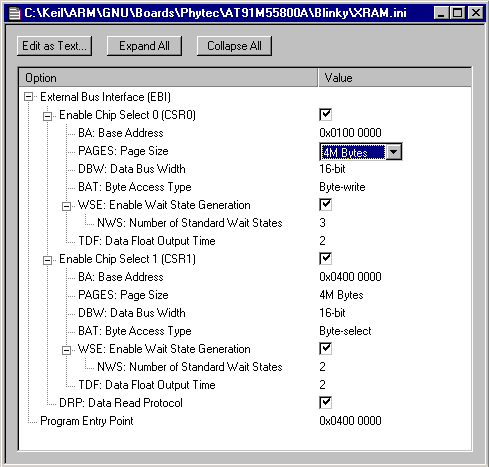|
||
| Products Download Events Support Videos | ||
Technical Support
On-Line Manuals
µVision3 User's Guide
Configuration Wizard
The µVision3 Configuration Wizard enables menu driven configuration of assembler, C, or debugger initialization files. The Configuration Wizard uses control items that are embedded into the comments of the configuration file.
A file that contains items for the Configuration Wizard must include the following text within the first 100 text lines. When this text appears the Editor will open the file in Configuration Wizard view.
<<< Use Configuration Wizard in Context Menu >>>
The following optional text marks the end of the Configuration Wizard section.
<<< end of configuration section >>>
Configuration Menu
The configuration menu is controlled by items and modifiers. The various control items and modifiers for the menu of the Configuration Wizard are described below:
| Item | Text | Description |
|---|---|---|
| <h> | yes | Heading: following options are within a group. |
| <e>§ | yes | Heading with Enable: following options are within a group that can be enabled via a Checkbox. |
| <e.4>§ | yes | Heading with Enable: modifies a specific bits (example bit 4) |
| </h> or </e> | yes | Heading or Enable end. |
| <i> | yes | Tool tip help for previous item. |
| <q>§ | yes | Option for bit values with displays a checkbox |
| <o>§ | yes | Option with selection or number entry |
| <o.4..5>§ | yes | modify bits in number (example bit 4 and bit 5) |
| <o.4>§ | yes | modify a single bit in number |
| <s>§ | yes | Option with string entry |
| <s.10>§ | yes | Option with string entry and size limit (10 characters) |
| Modifier | Description | |
| <0-31> | no | value range for options field |
| <0-100:10> | no | value range for options field with step 10 |
| <0x40-0x1000:0x10> | no | value range in hex format |
| <0=> | yes | value and text for selection |
| <#+1> <#-1> <#*8> <#/3> |
no | value modification (add, sub, mul, div) before number is merged into field |
Notes
-
By default, the next number or string is modified that follows
the comment section. Items marked with § can be followed
by a skip value, for example:
<o1>
The skip value is used to skip a number of items. The example above modifies therefore the second number that follows the comment. - Items of Modifiers can be followed by a text.
- White space characters are ignored in item or modifiers.
- As a guideline use symbol name from the device data sheets in front of the description.
Example
//*** <<< Use Configuration Wizard in Context Menu >>> ***
FUNC void Setup (void) {
// <h> External Bus Interface (EBI)
// <e1.13> Enable Chip Select 0 (CSR0)
// <o1.20..31> BA: Base Address <0x0-0xFFF00000:0x100000><#/0x100000>
// <i> Start Address for Chip Select Signal
// <o1.7..8> PAGES: Page Size <0=> 1M Byte <1=> 4M Bytes
// <2=> 16M Bytes <3=> 64M Bytes
// <i> Selects Active Bits in Base Address
// <o1.0..1> DBW: Data Bus Width <1=> 16-bit <2=> 8-bit
// <o1.12> BAT: Byte Access Type <0=> Byte-write
// <1=> Byte-select
// <e1.5> WSE: Enable Wait State Generation
// <o1.2..4> NWS: Number of Standard Wait States <1-8><#-1>
// </e>
// <o1.9..11> TDF: Data Float Output Time <0-7>
// <i> Number of Cycles Added after the Transfer
// </e>
_WDWORD(0xFFE00000, 0x010024A9); // EBI_CSR0: Flash
// <e1.13> Enable Chip Select 1 (CSR1)
// <o1.20..31> BA: Base Address <0x0-0xFFF00000:0x100000><#/0x100000>
// <i> Start Address for Chip Select Signal
// <o1.7..8> PAGES: Page Size <0=> 1M Byte <1=> 4M Bytes
// <2=> 16M Bytes <3=> 64M Bytes
// <i> Selects Active Bits in Base Address
// <o1.0..1> DBW: Data Bus Width <1=> 16-bit <2=> 8-bit
// <o1.12> BAT: Byte Access Type <0=> Byte-write
// <1=> Byte-select
// <e1.5> WSE: Enable Wait State Generation
// <o1.2..4> NWS: Number of Standard Wait States <1-8><#-1>
// </e>
// <o1.9..11> TDF: Data Float Output Time <0-7>
// <i> Number of Cycles Added after the Transfer
// </e>
_WDWORD(0xFFE00004, 0x040034A5); // EBI_CSR1: RAM
// <q1.4> DRP: Data Read Protocol
// <0=> Standard Read
// <1=> Early Read
_WDWORD(0xFFE00024, 0x00000010); // EBI_MCR: Data Read Protocol
_WDWORD(0xFFE00020, 0x00000001); // EBI_RCR: Remap Command
// </h>
// <o> Program Entry Point
PC = 0x04000000;
}
// <s> Change ID
// <s1.30> Change Password String
#define ID "My User ID"
char pw[] = "My Password";
When you open this example it generates the following dialogs:

ProductsDevelopment Tools |
Hardware & Collateral |
Downloads |
Support |
Contact |
